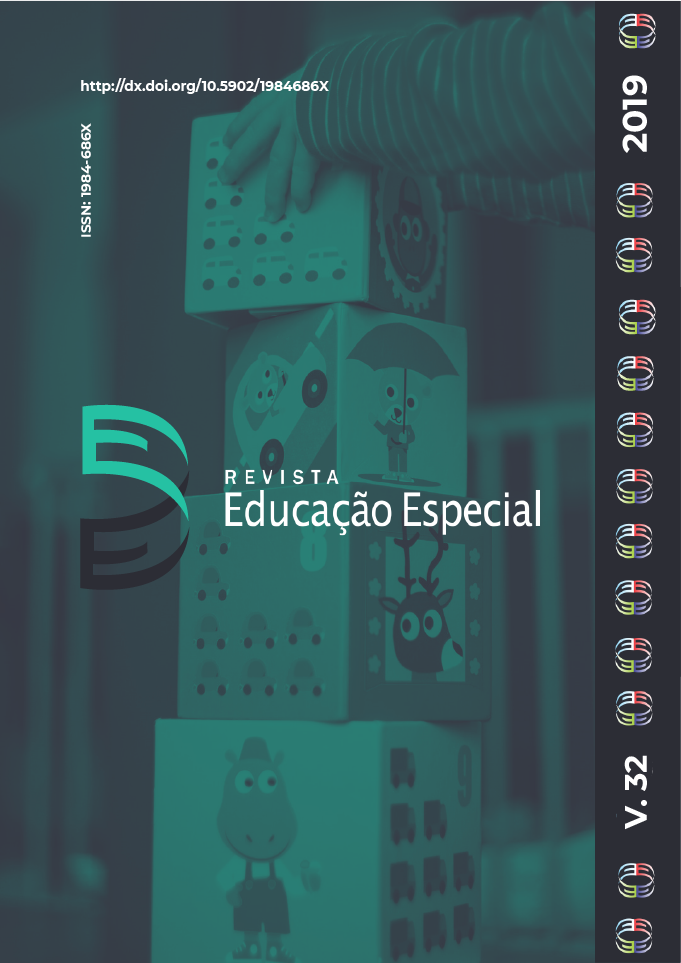The teaching of physics for young people with intellectual disabilities: a proposal to facilitate inclusion in the Regular School
DOI:
https://doi.org/10.5902/1984686X27590Keywords:
Inclusive education, Teaching of physics, Intellectual disability.Abstract
This work is a research that aims to find and disseminate methods that facilitate the learning process in physics teaching, for young people and adolescents, with intellectual disability and/or cognitive deficit. The project was developed with students from the third cycle of public education in Portugal, aged between fifteen and seventeen, attended by the school's special education and also attending a regular classroom. The general goal was to understand the methods and pedagogical tools that promote or facilitate the scientific learning considering the teaching of Physics. Three students from different grades were chosen with intellectual disabilities of different levels and individual meetings were done and assessed how the different methodologies could help in the understanding of the concepts that had been worked in the room. We used different teaching methods with different pedagogical tools, based on Vygotsky's work and, through the Bloom Taxonomy, we defined the level of learning for each topic. It was confirmed that actually to promote an inclusive school it is necessary that the methods are changed, the group work and technologies are used in the classroom and are also considered tailored curricula for each case.
Downloads
References
ANDERSON, L.W., et al. A taxonomy for learning, teaching and assessing: a revision of Bloom's taxonomy of educational objectives. Nova York: Addison Wesley Longman. 2001.
BLOOM, B.S.; HASTINGS, J.T.; MADANS, G.F.. Handbook on Formative and Sommative Evaluation of Student Learning. New York: McGraw Hill. 1971.
CAMARGO, E.P; VIVEIROS, E.R.; NARDI. R.. Trabalhando conceitos de óptica e eletromagnetismo com alunos com deficiência visual e videntes. X Encontro de Ensino de Física. Londrina. PR. Anais. 2006.
CARVALHO, E.N.S.; MACIEL, D.M.M.A.. Nova concepção de deficiência mental segundo a American Association on Mental Retardation - AAMR:sistema 2002. Temas em psicologia. v.11, n.2, 2003.
GONÇALVES, C.E.S; VAGULA, E.. Modificabilidade cognitiva estrutural de Reuven Feuerstein: uma perspectiva educacional voltada para o desenvolvimento cognitivo autônomo. IX ANPED Sul. Seminário em Pesquisa em Educação da Região Sul. Caxias do Sul. RS. Anais. 2012.
FERNANDÉZ, A.. Os idiomas do aprendente. Porto Alegre. Artmed. 2001.
FERRAZ, A.P.C.M.; BELHOT, R.V.. Taxonomia de Bloom: revisão teórica e apresentação das adequações do instrumento para definição de objetivos instrucionais. São Carlos. Gestão e Produção. v.17, n.2, 2010.
FEUERSTEIN, R. Instrumental Enrichment – An Intervention Program for Cognitive Modificability, Glenview, Illinois: Scott, Foresman and Company, 1980.
FREIRE, P.. Pedagogia do Oprimido. São Paulo. Editora Paz e Terra. 23 impressão. 1994.
LUCKASSON, R.; BORTHWICK-DUFFY, S.; BUNTINX, W. H. H.; COULTER, D. L.; Craig, E. M.; REEVE, A.; Snell, M. E. et al.. Mental Retardation – definition, classification, and systems of support. Washington, DC: American Association on Mental Retardation. 2002
MANTOAN, M.T. E.. Educação escolar de deficientes mentais: Problemas para a pesquisa e o desenvolvimento. Scielo Brasil. CEDES. Unicamp. SP. jan/abril, 46, 1999.
MANTOAN, M.T. E.. Inclusão escolar: O que é? Por quê? Como fazer? São Paulo. Summus Editorial. 2015.
PORTUGAL, Lei de 27 de agosto de 2009 Estabelece o regime da escolaridade obrigatória e dá outras providências. Diário da República, 1a série, n. 166. Portugal. 2009.
SAMPAIO, C.T.; SAMPAIO, S. MR.. Educação Inclusiva: o professor mediando para a vida. Salvador. EDUFBA. 2009.
UNESCO, Declaração de Salamanca e Enquadramento da Acção na Área das Necessidades Educativas Especiais. Instituto de Inovação Educacional, Lisboa, 1994.
VYGOTSKY, L.S.. Mind in Society - The development of higher psychological processes. Cambridge. MA: Harvard Univesity Press. 1978.
Downloads
Published
How to Cite
Issue
Section
License
Copyright (c) 2019 Revista Educação Especial

This work is licensed under a Creative Commons Attribution-NonCommercial 4.0 International License.
Declaration of originality
We declare that all articles present in the journal Revista Educação Especial (UFSM) are originals and were not submitted for publishing on any other publication, as a whole or a fraction. We also declare that, after being published by Revista Educação Especial (UFSM), a paper will not be submitted to another journal within two years. After this time, our journal transfers the publishing rights to the authors, with a permit granted by the Editorial Council.
We also acknowledge that the originals’ submission to Revista Educação Especial (UFSM) implies on a transference of copyright for physical and digital publishing to the journal. In case of noncompliance, the violator will receive sanctions and penalties predicted by the Brazilian Copyright Protection Law (n. 9610, dated 19/02/98).







